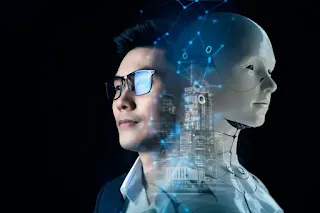Artificial intelligence, futuristic digital technology human and robot face close up, digital smart world metaverse concept
Diplomats roam the world, and secret meetings are often never made public.
For centuries, the art of conflict mediation has relied on precise human skills, from simple elements such as how to make eye contact and listen carefully, to detecting shifts in emotions and subtle signals from opponents.
Now a growing group of entrepreneurs and experts are working to introduce an exciting new set of tools to the world of dispute resolution, relying increasingly on artificial intelligence .
“Pioneering technological advances are revolutionizing the frontiers of peace and mediation,” said Sama Al-Hamdani, program director of Hala System, a private company that uses artificial intelligence and data analysis to gather unencrypted intelligence in conflict zones among other war-related tasks. “We are witnessing an era in which artificial intelligence transforms intermediaries into efficient and insightful centers of power,” she added.
Sama Al-Hamdani is one of thousands of speakers participating in the Doha Web Summit, where digital conflict mediation was on the agenda. The four-day summit began on February 26 and concluded on February 29.
Experts say digital solutions have already proven their effectiveness in complex diplomacy. At the height of coronavirus restrictions, mediators were unable to travel to attend in-person meetings with their interlocutors. The solution was to use the remote communication program "Skype" to facilitate negotiations, as the then US envoy Zalmay Khalilzad did in favor of the deal brokered by Qatar in the talks between the United States and the Taliban in 2020.
For generations, power brokers have met behind doors to make decisions that affect people on a large scale, and digital technologies can now allow the process to be relatively more inclusive.
This is what the Special Representative of the UN Secretary-General for Libya, Stephanie Williams, did in 2021, when she used a hybrid model integrating in-person and digital interactions as she led mediation efforts to develop a roadmap towards elections.
This strategy has helped her talk to people who live in areas deemed too dangerous to travel to. The United Nations estimates that Williams was able to reach one million Libyans.
However, practitioners are now increasingly interested in using technology beyond online consultations.
Geographic information systems (GIS) store information in maps to monitor ceasefire agreements, while at the same time virtual reality creates immersive environments that can provide diplomats with a deeper understanding of what is happening in the far-flung crises they mediate.
In 2021, the United Nations invited a group of diplomats to experience virtual reality to understand the work of its verification mission in Colombia on the country's peace process, and the ambassadors said they got an unusual glimpse into the context, fear and emotions that people are experiencing in the country.
“It is more direct, more emotional, and contains less letters and papers,” one diplomat said. Another said: “This can increase your awareness, and this can make diplomacy more effective.”
AI technology also enables rapid analysis of large amounts of data, breaking down months of work into a few minutes so that machines can read public sentiment and report on emerging threats to peace operations. Machine learning can recognize patterns or correlations and help create scenarios about what stakeholders might do and when.
A UN initiative has developed a pilot project in Uganda that uses artificial intelligence tools - such as speech recognition technology - to analyze large amounts of information from radio broadcasts, so that researchers can learn about public sentiment on issues ranging from climate change to refugees fleeing South Sudan. But it's not entirely rosy.
AI was developed by engineers who, like all humans, have their own biases, and experts warn that this technology is fed with data from the Internet, which can reinforce or amplify existing social biases and encourage discrimination.
At the same time, verifying information and gathering complex evidence is crucial at a time when photos are faked or news is so easy.
Zalmay Khalilzad, the US envoy to Afghanistan
“In any conflict resolution you need a common basis of evidence so that both parties come to that mediation saying, ‘This is what we all know to be true,’” said Mansoor Ahmed Ringers, founder of Open Origins, an app that helps resolve conflict. Ahmed, who participated in the Doha Web Summit, added: “If there is no basis for a common belief or common understanding of a situation, then there is no mediation that can happen.”
Online legal information and decisions or voting records must be documented and stored in a secure location so that they are not destroyed. A super-secure, underground bank vault is of no use in the era of Web 3.0. Today, the goal is to store digital materials in as many places as possible, analysts say.
This is what blockchain technologies do , they hold the material in a decentralized and immutable system.
Richard Gowan, director of the United Nations International Crisis Group, says: Digital technologies are becoming more common in peacemaking, and they allow mediators to see conflicts anew. He adds: “But I also believe that we must remember that the heart of any political process remains between individuals who have deep prejudices, fears, and ideologies Unless we develop technology that erases people’s memories from the Men in Black movies, the human dimension of peace will remain crucial.” ".


Human biases and the need for common ground remain critical for successful resolutions.
ReplyDeleteInformative
ReplyDelete